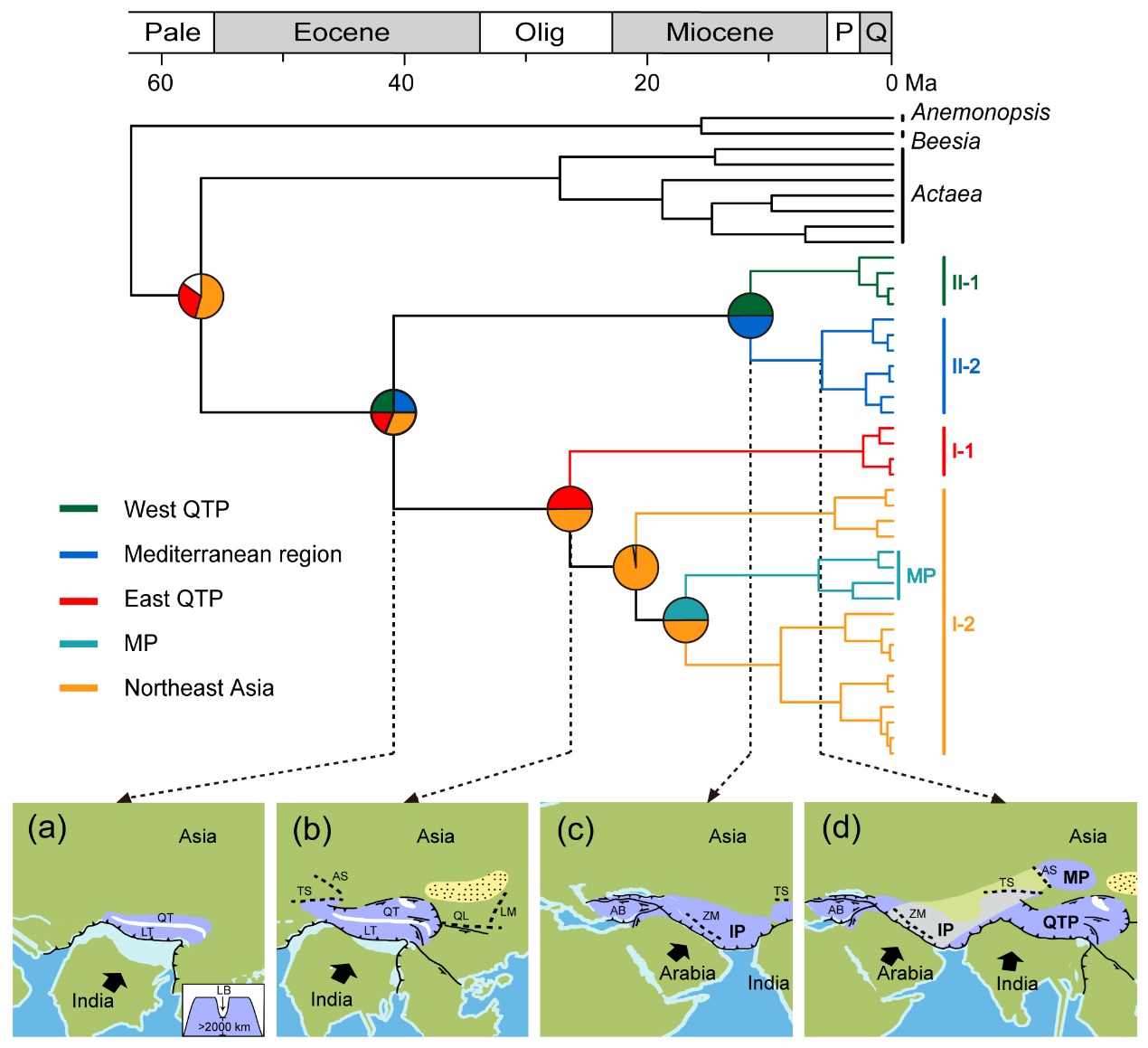The collisions of Indian Subcontinent with Eurasia in the east and Arabian plate with Eurasia in the west are two important tectonic events in Asia, and have greatly changed Asian topography and affected regional and global climate as well as biotic evolution.
However, the geological evolution of Asia related to these two collisions remains debated.
The evolutionary history of organisms with poor dispersal abilities usually parallels geological events. A research group led by Prof. WANG Wei from the Institute of Botany, Chinese Academy of Sciences (IBCAS) used Eranthis, an angiosperm genus with poor dispersal ability and a discontinuous distribution across Eurasia, to shed light on the orogenesis of the Qinghai-Tibetan, Iranian and Mongolian plateaus.
The researchers found that biogoegraphic patterns of Eranthis might have been shaped mainly by geography. Within Eranthis, four vicariance events well correlated the two early uplifts of the Tibetan plateau during the late Eocene and the Oligocene–Miocene boundary and the two uplifts of the Iranian Plateau during the middle Miocene and the late Miocene.
The origin and divergence of the Mongolian Plateau taxa were related to the two uplifts of the Mongolian Plateau during the middle Miocene and the late Miocene.
The researchers provide the first case of an organismal group reconciling and illuminating critical aspects of the timing of the growth of all three great Asian Plateaus. They document that the three great Asian Plateaus each experienced multistage uplift processes. After the first uplift (c. 40 Ma), the central part of Tibet only reached an altitude of <2.3 km.
Moreover, they also find that an uplift in the Iranian Plateau and lateral extrusion of the Anatolian block occurred simultaneously at about 12 Ma. It is the first time using modern phylogenetic and biogeographic methods to examine the lateral extrusion of the Anatolian block.
Additionally, the findings suggest that the Mongolian plateau might be the consequence of the far-field effect of the India-Eurasia and Arabia-Eurasia collisions.
"These hypotheses will change considerably our current concepts of the geological evolution of Asia related to the India-Eurasia and Arabia-Eurasia collisions as a whole, and can be used to explain the evolutionary history of other extant lineages that exhibit similar habitat requirements and dispersal abilities with Eranthis in Eurasia.", said Prof. WANG Wei, correspondence author of the study.
The above study has been published online in Proceedings of the Royal Society B: Biological Sciences.

Evolution of Eranthis with associated tectonic events (Image by IBCAS)
Article Link: https://doi.org/10.1098/rspb.2021.0281
Contact:
Email: wangwei1127@ibcas.ac.cn
Institute of Botany,Chinese Academy of Sciences (IBCAS)
The collisions of Indian Subcontinent with Eurasia in the east and Arabian plate with Eurasia in the west are two important tectonic events in Asia, and have greatly changed Asian topography and affected regional and global climate as well as biotic evolution.
However, the geological evolution of Asia related to these two collisions remains debated.
The evolutionary history of organisms with poor dispersal abilities usually parallels geological events. A research group led by Prof. WANG Wei from the Institute of Botany, Chinese Academy of Sciences (IBCAS) used Eranthis, an angiosperm genus with poor dispersal ability and a discontinuous distribution across Eurasia, to shed light on the orogenesis of the Qinghai-Tibetan, Iranian and Mongolian plateaus.
The researchers found that biogoegraphic patterns of Eranthis might have been shaped mainly by geography. Within Eranthis, four vicariance events well correlated the two early uplifts of the Tibetan plateau during the late Eocene and the Oligocene–Miocene boundary and the two uplifts of the Iranian Plateau during the middle Miocene and the late Miocene.
The origin and divergence of the Mongolian Plateau taxa were related to the two uplifts of the Mongolian Plateau during the middle Miocene and the late Miocene.
The researchers provide the first case of an organismal group reconciling and illuminating critical aspects of the timing of the growth of all three great Asian Plateaus. They document that the three great Asian Plateaus each experienced multistage uplift processes. After the first uplift (c. 40 Ma), the central part of Tibet only reached an altitude of <2.3 km.
Moreover, they also find that an uplift in the Iranian Plateau and lateral extrusion of the Anatolian block occurred simultaneously at about 12 Ma. It is the first time using modern phylogenetic and biogeographic methods to examine the lateral extrusion of the Anatolian block.
Additionally, the findings suggest that the Mongolian plateau might be the consequence of the far-field effect of the India-Eurasia and Arabia-Eurasia collisions.
"These hypotheses will change considerably our current concepts of the geological evolution of Asia related to the India-Eurasia and Arabia-Eurasia collisions as a whole, and can be used to explain the evolutionary history of other extant lineages that exhibit similar habitat requirements and dispersal abilities with Eranthis in Eurasia.", said Prof. WANG Wei, correspondence author of the study.
The above study has been published online in Proceedings of the Royal Society B: Biological Sciences.

Evolution of Eranthis with associated tectonic events (Image by IBCAS)
Article Link: https://doi.org/10.1098/rspb.2021.0281
Contact:
Email: wangwei1127@ibcas.ac.cn
Institute of Botany,Chinese Academy of Sciences (IBCAS)
